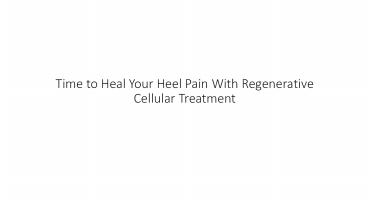Time to heel your heal pain with regenerative treatment - PowerPoint PPT Presentation
Title:
Time to heel your heal pain with regenerative treatment
Description:
When you get up in the morning with pain in one or both heels, and if it doesn’t go away by itself after a few days, there is a chance that you have developed, Plantar Fasciitis. You’ll feel heel pain while walking after a period of sitting down in a car driving or at your office desk. – PowerPoint PPT presentation
Number of Views:1
Title: Time to heel your heal pain with regenerative treatment
1
Time to Heal Your Heel Pain With Regenerative
Cellular Treatment
2
(No Transcript)
3
- For good health, daily exercise is essential at
any age. Walking is considered an ideal physical
activity. - But if any part of your foot is in poor health, a
vicious cycle of pain will get created. - It can result in a lack of activity due to fear
of pain. - From this article, you can identify your symptoms
if you are experiencing heel pain while walking. - Also, you can learn about varied available
conventional methods for heel pain.
4
When do your heels hurt?
- When you get up in the morning with pain in one
or both heels, and if it doesnt go away by
itself after a few days, there is a chance that
you have developed, Plantar Fasciitis. - Youll feel heel pain while walking after a
period of sitting down in a car driving or at
your office desk. - Plantar Fasciitis is a strain, inflammation, and
injury to the stretchy plantar fascia ligament. - It spans the arch of your foot from the heel to
the ball. When you sleep or remain seated for a
long time, the ligament becomes still and cool. - This, in turn, makes the pain worse when you
first get up to your feet. - As you begin to walk around, you will notice that
the heel pain decreases. - It is because the ligament has had a chance to
warm up.
5
When do your heels hurt?
- Temporarily a few minutes of walking can help to
reduce the sensation of heel pain. - Youll notice that any attempt to walk or run any
significant distance can make the pain worse. - This can be a symptom of Plantar Fasciitis.
- It may also indicate a condition involving the
tendon of the calf and ankle called Achilles
Tendinitis. - If your daily walk is accompanied by a sensation
of being jabbed in the heel by a small pebble,
you may have developed a heel spur. - It is a bony calcium build up on the heel bone.
- These protrusions can be pointed.
- It can be hooked or shelf-shaped and can prod
into the soft, fatty tissue cushioning your heel
as you walk. This, in turn, can cause moderate to
severe pain.
6
When do your heels hurt?
- In short, both morning heel pain and heel pain
while walking are indications that you are having
a physical ailment of the foot. - It is not safe to ignore such symptoms as it can
lead to further damage and increasing debility.
7
Breaking the cycle of heel pain
- Ignoring heel pain and continuing to exercise can
worsen a condition like Plantar Fasciitis. - Your body will try to protect any part of the
foot that has been injured as you walk or run. - Youll try to favour the ball in your gait
instead of correctly distributing the impact of
your steps from ball to heel. - This will strain the damaged plantar fascia
ligament as it stretches. - Further, it will increase inflammation and small
tears in the ligament tissues. - Finally, the heel pain will become so severe that
youll have to give up exercise. - In turn, youll put on weight, and therell be a
greater risk for injuries to the ligaments and
tendons of your feet. - Its proven that more than 90 of plantar
fasciitis can be heeled with conservative and
at-home remedies. Only extreme cases need
surgeries.
8
There are substantial reasons for you to opt for
our Medica stem cell therapy
- Regenerative cellular treatment is a
non-surgical, minimally invasive, same-day
procedure. You will be completely conscious
during this procedure. - Unlike other methods, regenerative cellular
treatment naturally repairs your damaged tissues.
Furthermore, it can help you recover from the
associated symptoms permanently. That too, within
a short duration. - Regenerative cellular treatment prompts your
healing mechanism using your own body cells.
Hence, there is no possibility of rejection or
allergy.
9
Platelet-rich plasma (PRP) is an
- Autologous blood-derived plasma fraction rich in
platelet and growth factors, which can promote
tissue repair. - Platelet-rich plasma (PRP) is an autologous
blood-derived plasma fraction rich in platelet
and growth factors, which can promote tissue
repair. - Platelet-rich plasma (PRP) is an autologous
blood-derived plasma fraction rich in platelet
and growth factors, which can promote tissue
repair. - Contact Medica Stem Cells clinic in Ireland at 01
298 8000 or in London at 020 8 168 2000 to know
more about our Medica Stem Cell therapy for heel
pain. Remember, we also offer physical therapy
and nutritional therapy to accelerate your
healing process.































